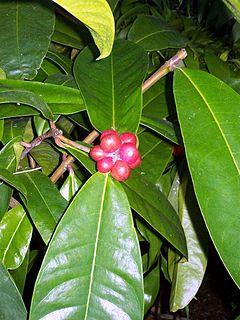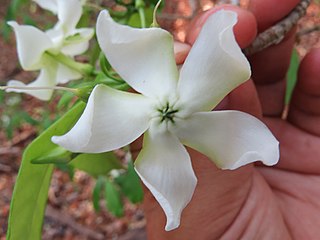
Royal Botanic Gardens, Kew is a non-departmental public body in the United Kingdom sponsored by the Department for Environment, Food and Rural Affairs. An internationally important botanical research and education institution, it employs 1,100 staff. Its board of trustees is chaired by Dame Amelia Fawcett.

Taiwania, with the single living species Taiwania cryptomerioides, is a large coniferous tree in the cypress family Cupressaceae.
Aparisthmium is a plant genus of the family Euphorbiaceae first described as a genus in 1840. It contains only one known species, Aparisthmium cordatum, native to South America and Costa Rica.

Sophora toromiro, commonly known as Toromiro, is a species of flowering tree in the legume family, Fabaceae, that is endemic to Easter Island. Heavy deforestation had eliminated most of the island's forests by the first half of the 17th century, and the once common toromiro became rare and ultimately extinct in the wild in the 1950s.
Millettia richardiana is a species of legume in the family Fabaceae. It is found only in Madagascar.

Caryota no is a species of flowering plant in the family Arecaceae. It is endemic to the Island of Borneo. Its specific epithet is from the common name in Malaysian, cajù nó. It is called baroch by the Dayak people of Singhi. The fibers, which are used for fishing lines or woven into baskets, are called talì onus. The extremely hard wood is also used like similar species.
Aquilaria microcarpa is a species of plant in the Thymelaeaceae family. It is found in Indonesia and Singapore.
Phyllanthus pavonianus, synonym Phyllanthus haughtii, is a species of plant in the family Phyllanthaceae. It is native from south Ecuador to north-west Peru. Its natural habitat is subtropical or tropical moist montane forests. Under the synonym Phyllanthus haughtii, it has been regarded as "endangered".
Phyllanthus revaughanii is a species of flowering plant in the family Phyllanthaceae, native to the Mascarene Islands and the Mozambique Channel Islands. Its natural habitat is rocky shores.
Phyllanthus sponiifolius is a species of plant in the family Phyllanthaceae. It is native to Colombia and Ecuador. Its natural habitat is subtropical or tropical moist montane forests.

Anacamptis palustris is a species of orchid. It is found in Europe, North Africa and western Asia. This orchid is native to Western and Central Europe, the Mediterranean region, the Balearic Islands, Turkey, Western Asia, Algeria and Tunisia in North Africa, and Saudi Arabia.

Phaleria octandra is a flowering plant in the Thymelaeaceae family. It is a shrub found in tropical Australia. It is also naturally found in the New Guinea, Indonesia, Malaysia and the Solomon Islands.

Tabernaemontana crassa is a plant in the dogbane family Apocynaceae, native to tropical Africa.

Lumnitzera racemosa, commonly known as the white-flowered black mangrove, is a species of mangrove in the family Combretaceae. It is found on the eastern coast of Africa and other places in the western Indo-Pacific region. It has one accepted variety from the noniminate species, Lumnitzera racemosa var. lutea (Gaudich.) Exell.

Tabernaemontana amygdalifolia is a species of plant in the family Apocynaceae. It is native to southern Mexico, Central America, Cuba, Haiti, and northwestern South America.

Oeceoclades seychellarum is a terrestrial orchid species in the genus Oeceoclades that was endemic to the island of Mahé in the Seychelles but is now considered to be extinct. Its sepals and petals are yellowish-white, while the labellum is white with some streaks. This species is only represented by the type specimen, collected in May 1902 from the Cascade Estate on the island of Mahé at an elevation of 900 feet (270 m) in what was then a mountain forest. The location from which the type specimen was collected is now degraded by human activity and invasive plants. Oeceoclades seychellarum was listed as being cultivated at the Royal Botanic Gardens, Kew in 1905, but not after that date.
Phyllanthus societatis is a species of flowering plant in the family Phyllanthaceae, native to Nauru, the Cook Islands and the Tuamotus, in the Pacific Ocean. The species was first described in 1866 by Johannes Müller Argoviensis.
Phyllanthus distichus is a species of flowering plant in the family Phyllanthaceae, native to the Hawaiian Islands.

Phyllanthus tenellus is a herbaceous plant in the leafflower family, Phyllanthaceae. It is commonly called Mascarene Island leaf flower as it is native to the Mascarene Islands. It is often a weed in flower beds, gardens, roadsides, and other disturbed areas.
Tropical Important Plant Areas (TIPAs) is a programme established by the Royal Botanic Gardens, Kew in 2015 in collaboration with Plantlife International, to provide a framework to identify sites important for preserving plant diversity in tropical countries. The programme is based on the Important Plant Areas (IPAs) framework set up by Plantlife International. The IPA criteria were modified to take into account the high plant richness, the limited availability of data and the higher dependence on socio-economically important yet native plants for livelihoods in the tropics. The framework acknowledges the practical problems of gathering plant and habitat data in many regions of the world, and it recognises the important role of peer reviewed expert opinion in the selection process. TIPAs can be identified based on a range of organism groups within the plant and fungal kingdoms, including algae, fungi, lichens, liverworts, mosses, and wild vascular plants. The TIPAs programme focuses on critical sites for wild plant populations. It aims to identify areas important for the conservation of threatened plants and/or habitats and areas with exceptional plant richness, and to raise awareness of the importance of plant life in tropical countries, encouraging long term conservation of these areas. TIPA sites are selected based on three criteria:











